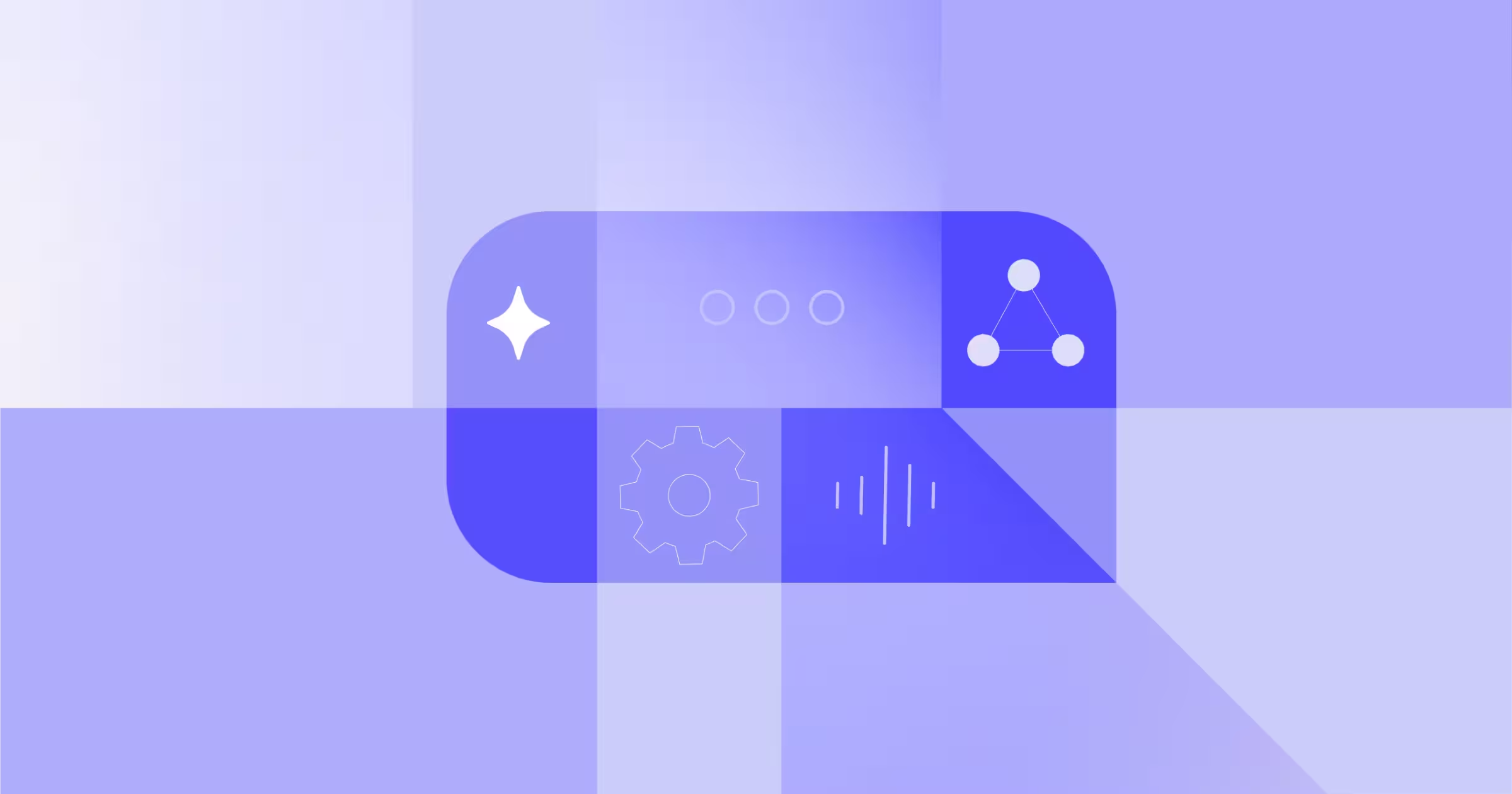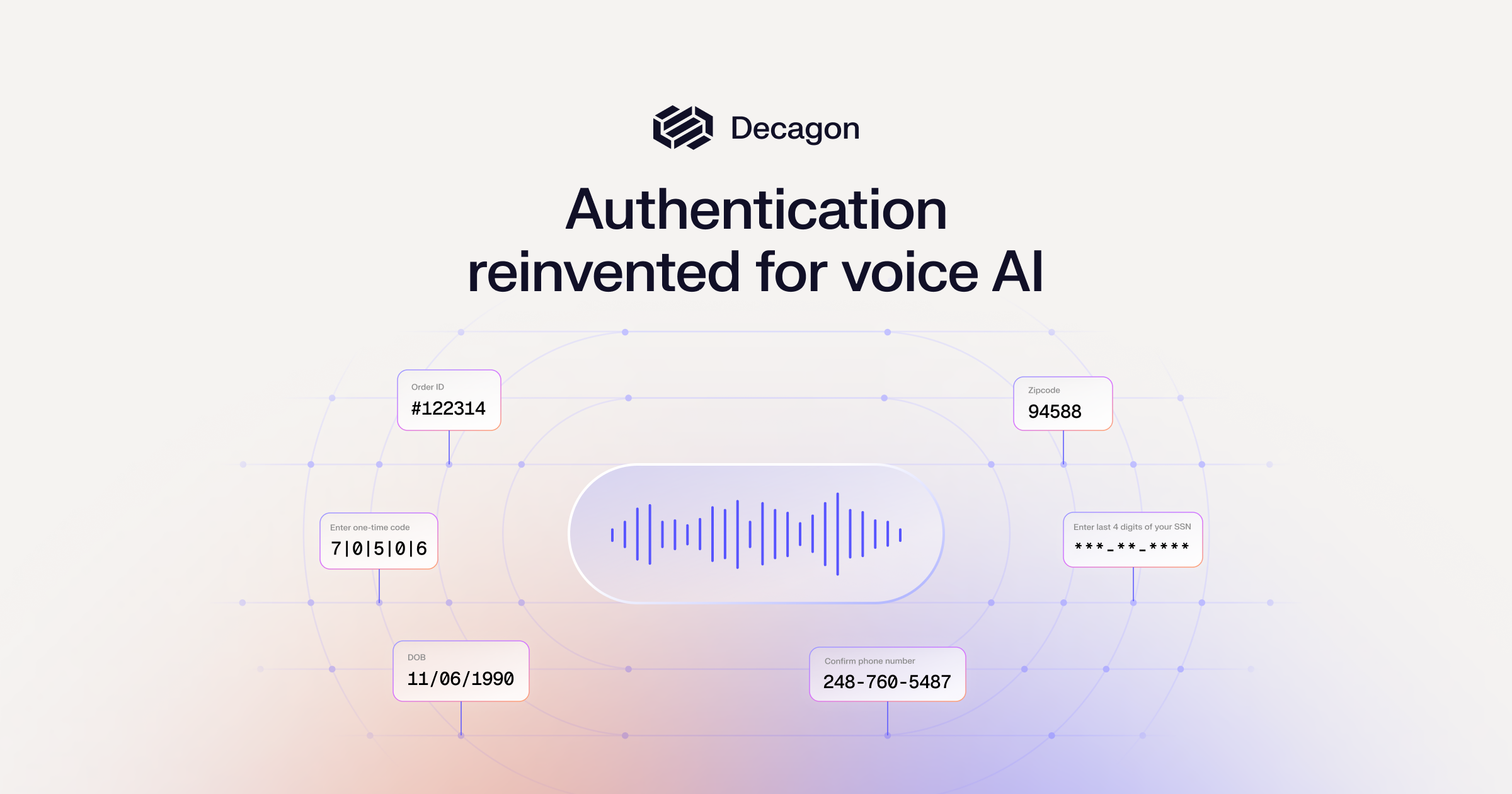How conversational AI components work together in customer service
Learn how architectural patterns between conversational AI components prevent retry storms, context breaks & budget overruns.

For years, we’ve been told that building a great AI-powered chatbot is about picking the right pieces: the smartest Large Language Model (LLM), the most accurate Natural Language Processing (NLP) engine, or the most human-sounding voice generator.
Yet, most chatbots that implement these features stumble or fail in production, leaving teams with unreliable bots and frustrated customers.
Why? Because success isn’t about having the best individual components. It's about the architectural patterns that connect them.
When a company like Notion trusts Decagon to manage a million annual conversations, they aren't just betting on a better model. They are validating the approach that the connections between your AI components are as important as the components themselves.
This guide provides a practical blueprint for reliably wiring your conversational AI components together. We’ll discuss the five critical boundaries where systems typically falter, empowering you to build a resilient, scalable agent you can finally ship with confidence.
What is conversational AI?
Conversational AI is the technology that enables machines to understand, process, and respond to human language in a natural, back-and-forth dialogue.
You’ve likely encountered its simpler cousin: the traditional chatbot, which follows rigid, pre-programmed scripts. True conversational AI, however, uses natural language processing (NLP) and machine learning to manage complex interactions, remember context, and, most importantly, get things done.
This distinction is critical in customer service.
- A basic chatbot operates on simple if/then logic. When you ask, “Can I return this item?”, it follows a script to show you the return policy.
- Conversational, agentic AI tackles complexity. It can process a multi-part request like, “I need to change my flight to Tuesday, keep the same return date, and add my frequent flyer number.”
The real advantage is this shift from passive conversation to meaningful action. Modern systems go beyond simple chats to understand intent, extract key details, and integrate with business systems to execute tasks.
Action-oriented platforms like Decagon are built for this, achieving high resolution rates by implementing Agent Operating Procedures (AOPs). They uniquely allow business teams to define complex workflows in natural language, while engineers retain full control over security and integrations.
What are the components of conversational AI?
Conversational AI uses five core components: user interface, input analyzer, dialogue manager, integrations module, and output module. However, successful systems depend more on the contracts between these components than on the components themselves.
This five-part architecture forms the technical foundation of the system:
- User interface. This is the front door where a customer interacts with the system, whether through a chat widget, email, or a voice call.
- Input analyzer. This is the brain of the operation. It uses a combination of Natural Language Understanding (NLU) and Large Language Models (LLMs) to determine the user's intent and extract key entities.
- Dialogue manager. Acting as the system's short-term memory, this component tracks the conversation's state to maintain context.
- Integrations module. These are the hands that perform actions, connecting to business systems like a CRM or booking platform.
- Output module. This is the final step, where the system generates a natural, helpful response to the user.
These components only become a powerful system through a thoughtful architecture that defines the rules of engagement between them. For example, a Unified Knowledge Graph can preserve context even if a user switches from a chat to a phone call. This robust structure is what allows an AI agent to handle complex, multi-step workflows, elevating it from a simple chatbot into a true problem-solver.
Why production chatbots fail
Chatbots fail in production when undefined behavior between components creates cascade failures, retry storms, and streaming breaks. These failures occur regardless of component quality because they stem from a lack of explicit promises, or "interface contracts," that govern how the components interact under stress.
For example, a minor speech recognition error can lead to the NLU misclassifying the user's intent, which confuses the dialogue manager, resulting in a nonsensical response and a frustrated customer.
To prevent these meltdowns, robust systems are built with enterprise-grade guardrails, such as automated checks and balances designed to contain errors before they escalate. These interface contracts are explicit promises between conversational AI components that prevent cascade failures. They turn a fragile collection of parts into a resilient system.
Key guardrails include:
- Response validation. Automatically checks AI-generated answers for factual errors or "hallucinations" before they ever reach the customer.
- Exponential backoff. Prevents a system from overloading itself by intelligently spacing out retries if an external service fails (e.g., waiting 1s, then 2s, then 4s).
- Confidence thresholds. Escalates a conversation to a human agent if the AI's confidence in its own answer drops below a safe level.
- State persistence. Uses a Unified Knowledge Graph to remember conversation history, so customers never have to repeat themselves, even if they switch channels.
Without these controls, teams face common disasters, such as retry storms that consume API budgets overnight or context breaks that disrupt the user experience.
This is why modern platforms embed these safeguards directly into their architecture. Decagon provides a Watchtower feature for real-time observability into every model call and decision, plus advanced testing suites to simulate and fix complex dialogues long before they go into production.
Building and operating your conversational AI stack
Building a reliable conversational AI agent used to mean manually selecting, subscribing to, and stitching together five to seven different cloud services for things like natural language understanding, state management, and response generation.
This approach is complex, requiring engineers to manage multiple API keys, versions, and failure points, and also incredibly brittle as a single change in one service could break the entire system.
Modern platforms abstract away this integration complexity, providing a managed runtime where teams can focus on a streamlined, three-phase process to train, launch, and continuously improve their agent.
Phase 1: Knowledge ingestion
The foundation of any intelligent agent is its knowledge. This phase involves connecting the AI to your core business data sources. Rather than just uploading FAQs, you provide access to dynamic information from:
- Knowledge bases like Zendesk, Guru, or Confluence.
- Customer relationship management (CRM) systems.
- Historical conversation logs.
- Internal business APIs that contain real-time data on orders or user accounts.
A Unified Knowledge Graph then automatically processes this information, inferring relationships, identifying key entities like 'SKU' or 'order_id', and creating a structured map of your business's operational reality that the AI can instantly query.
Phase 2: Natural language configuration
With its knowledge base established, the next step is to teach the AI how to act. This is where Agent Operating Procedures (AOPs) represent a paradigm shift. Instead of requiring developers to code complex logic, AOPs allow customer experience (CX) and business teams to define workflows in plain English.
For example, a CX manager could write a rule like: "WHEN a user reports a 'shipping_delay' AND the 'order_age' from our CRM is > 5 days, THEN first 'validate_address' with the user, and THEN 'offer_choice' between a 'refund' or 'expedited_replacement'."
This empowers the people who best understand customer policy to directly build and edit AI behavior, dramatically speeding up development.
Phase 3: Continuous learning and improvement
Once live, the system should be designed to learn from every interaction. When it encounters a question it can't answer or notices a new pattern of user requests (like a spike in questions about a new product), it automatically flags these "knowledge gaps."
This creates a powerful feedback loop where analysts can review flagged conversations, add new information to the knowledge base, and refine workflows, ensuring the AI gets smarter and more helpful over time.
Observability and the challenge of voice
Operating a black-box AI is a major operational risk. Effective AI observability means monitoring the critical boundaries between components. Instead of just tracking basic technical stats, you need to focus on business-impact metrics:
- Intent confidence: How sure was the AI about what the user wanted?
- API latency: Did a slow connection to an internal tool ruin the user experience?
- Error rates: Which specific integration point is failing most often?
Tools like Decagon's Watchtower provide end-to-end tracing for every conversation, allowing you to pinpoint the exact model call or component that caused an issue. This shifts the focus from "Is the API up?" to "Did we resolve the customer's issue?"
This becomes even more critical for voice agents, which add five more complex, real-time layers: Automatic Speech Recognition (ASR), Voice Activity Detection (VAD), interruption handling, Text-to-Speech (TTS), and telephony integration. To feel natural and prevent users from talking over the AI, voice components require strict ASR and TTS latency contracts under 200ms. Orchestrating these services is an immense engineering challenge, which is why modern platforms consolidate them into a single, pre-integrated stack.
An operational excellence framework
This rich data from observability feeds a weekly operational excellence review. In this meeting, teams analyze the top failure patterns and escalations to human agents.
Was the AI's confidence threshold too high? Did a workflow prove confusing for users?
Based on these insights, the team can take precise, targeted actions, like updating a help document, adjusting a guardrail, or redesigning a dialogue flow, to systematically improve the agent's performance and reliability week after week.
Making your components work as one system
Successful conversational AI doesn't come from a single brilliant model but from a well-architected system. As we've seen, production failures rarely happen because an AI model is flawed, but rather because the connections between components are fragile and undefined.
Today, anyone can access powerful LLMs like GPT-5 or Claude. The real differentiator is the architecture that controls them with explicit guardrails for safety, reliability, and context. This is what turns a collection of powerful parts into a trustworthy, high-performing agent that solves customer problems.
Ready to see how a truly unified system works? Get a demo of Decagon today.
How conversational AI components work together in customer service
September 23, 2025

For years, we’ve been told that building a great AI-powered chatbot is about picking the right pieces: the smartest Large Language Model (LLM), the most accurate Natural Language Processing (NLP) engine, or the most human-sounding voice generator.
Yet, most chatbots that implement these features stumble or fail in production, leaving teams with unreliable bots and frustrated customers.
Why? Because success isn’t about having the best individual components. It's about the architectural patterns that connect them.
When a company like Notion trusts Decagon to manage a million annual conversations, they aren't just betting on a better model. They are validating the approach that the connections between your AI components are as important as the components themselves.
This guide provides a practical blueprint for reliably wiring your conversational AI components together. We’ll discuss the five critical boundaries where systems typically falter, empowering you to build a resilient, scalable agent you can finally ship with confidence.
What is conversational AI?
Conversational AI is the technology that enables machines to understand, process, and respond to human language in a natural, back-and-forth dialogue.
You’ve likely encountered its simpler cousin: the traditional chatbot, which follows rigid, pre-programmed scripts. True conversational AI, however, uses natural language processing (NLP) and machine learning to manage complex interactions, remember context, and, most importantly, get things done.
This distinction is critical in customer service.
- A basic chatbot operates on simple if/then logic. When you ask, “Can I return this item?”, it follows a script to show you the return policy.
- Conversational, agentic AI tackles complexity. It can process a multi-part request like, “I need to change my flight to Tuesday, keep the same return date, and add my frequent flyer number.”
The real advantage is this shift from passive conversation to meaningful action. Modern systems go beyond simple chats to understand intent, extract key details, and integrate with business systems to execute tasks.
Action-oriented platforms like Decagon are built for this, achieving high resolution rates by implementing Agent Operating Procedures (AOPs). They uniquely allow business teams to define complex workflows in natural language, while engineers retain full control over security and integrations.
What are the components of conversational AI?
Conversational AI uses five core components: user interface, input analyzer, dialogue manager, integrations module, and output module. However, successful systems depend more on the contracts between these components than on the components themselves.
This five-part architecture forms the technical foundation of the system:
- User interface. This is the front door where a customer interacts with the system, whether through a chat widget, email, or a voice call.
- Input analyzer. This is the brain of the operation. It uses a combination of Natural Language Understanding (NLU) and Large Language Models (LLMs) to determine the user's intent and extract key entities.
- Dialogue manager. Acting as the system's short-term memory, this component tracks the conversation's state to maintain context.
- Integrations module. These are the hands that perform actions, connecting to business systems like a CRM or booking platform.
- Output module. This is the final step, where the system generates a natural, helpful response to the user.
These components only become a powerful system through a thoughtful architecture that defines the rules of engagement between them. For example, a Unified Knowledge Graph can preserve context even if a user switches from a chat to a phone call. This robust structure is what allows an AI agent to handle complex, multi-step workflows, elevating it from a simple chatbot into a true problem-solver.
Why production chatbots fail
Chatbots fail in production when undefined behavior between components creates cascade failures, retry storms, and streaming breaks. These failures occur regardless of component quality because they stem from a lack of explicit promises, or "interface contracts," that govern how the components interact under stress.
For example, a minor speech recognition error can lead to the NLU misclassifying the user's intent, which confuses the dialogue manager, resulting in a nonsensical response and a frustrated customer.
To prevent these meltdowns, robust systems are built with enterprise-grade guardrails, such as automated checks and balances designed to contain errors before they escalate. These interface contracts are explicit promises between conversational AI components that prevent cascade failures. They turn a fragile collection of parts into a resilient system.
Key guardrails include:
- Response validation. Automatically checks AI-generated answers for factual errors or "hallucinations" before they ever reach the customer.
- Exponential backoff. Prevents a system from overloading itself by intelligently spacing out retries if an external service fails (e.g., waiting 1s, then 2s, then 4s).
- Confidence thresholds. Escalates a conversation to a human agent if the AI's confidence in its own answer drops below a safe level.
- State persistence. Uses a Unified Knowledge Graph to remember conversation history, so customers never have to repeat themselves, even if they switch channels.
Without these controls, teams face common disasters, such as retry storms that consume API budgets overnight or context breaks that disrupt the user experience.
This is why modern platforms embed these safeguards directly into their architecture. Decagon provides a Watchtower feature for real-time observability into every model call and decision, plus advanced testing suites to simulate and fix complex dialogues long before they go into production.
Building and operating your conversational AI stack
Building a reliable conversational AI agent used to mean manually selecting, subscribing to, and stitching together five to seven different cloud services for things like natural language understanding, state management, and response generation.
This approach is complex, requiring engineers to manage multiple API keys, versions, and failure points, and also incredibly brittle as a single change in one service could break the entire system.
Modern platforms abstract away this integration complexity, providing a managed runtime where teams can focus on a streamlined, three-phase process to train, launch, and continuously improve their agent.
Phase 1: Knowledge ingestion
The foundation of any intelligent agent is its knowledge. This phase involves connecting the AI to your core business data sources. Rather than just uploading FAQs, you provide access to dynamic information from:
- Knowledge bases like Zendesk, Guru, or Confluence.
- Customer relationship management (CRM) systems.
- Historical conversation logs.
- Internal business APIs that contain real-time data on orders or user accounts.
A Unified Knowledge Graph then automatically processes this information, inferring relationships, identifying key entities like 'SKU' or 'order_id', and creating a structured map of your business's operational reality that the AI can instantly query.
Phase 2: Natural language configuration
With its knowledge base established, the next step is to teach the AI how to act. This is where Agent Operating Procedures (AOPs) represent a paradigm shift. Instead of requiring developers to code complex logic, AOPs allow customer experience (CX) and business teams to define workflows in plain English.
For example, a CX manager could write a rule like: "WHEN a user reports a 'shipping_delay' AND the 'order_age' from our CRM is > 5 days, THEN first 'validate_address' with the user, and THEN 'offer_choice' between a 'refund' or 'expedited_replacement'."
This empowers the people who best understand customer policy to directly build and edit AI behavior, dramatically speeding up development.
Phase 3: Continuous learning and improvement
Once live, the system should be designed to learn from every interaction. When it encounters a question it can't answer or notices a new pattern of user requests (like a spike in questions about a new product), it automatically flags these "knowledge gaps."
This creates a powerful feedback loop where analysts can review flagged conversations, add new information to the knowledge base, and refine workflows, ensuring the AI gets smarter and more helpful over time.
Observability and the challenge of voice
Operating a black-box AI is a major operational risk. Effective AI observability means monitoring the critical boundaries between components. Instead of just tracking basic technical stats, you need to focus on business-impact metrics:
- Intent confidence: How sure was the AI about what the user wanted?
- API latency: Did a slow connection to an internal tool ruin the user experience?
- Error rates: Which specific integration point is failing most often?
Tools like Decagon's Watchtower provide end-to-end tracing for every conversation, allowing you to pinpoint the exact model call or component that caused an issue. This shifts the focus from "Is the API up?" to "Did we resolve the customer's issue?"
This becomes even more critical for voice agents, which add five more complex, real-time layers: Automatic Speech Recognition (ASR), Voice Activity Detection (VAD), interruption handling, Text-to-Speech (TTS), and telephony integration. To feel natural and prevent users from talking over the AI, voice components require strict ASR and TTS latency contracts under 200ms. Orchestrating these services is an immense engineering challenge, which is why modern platforms consolidate them into a single, pre-integrated stack.
An operational excellence framework
This rich data from observability feeds a weekly operational excellence review. In this meeting, teams analyze the top failure patterns and escalations to human agents.
Was the AI's confidence threshold too high? Did a workflow prove confusing for users?
Based on these insights, the team can take precise, targeted actions, like updating a help document, adjusting a guardrail, or redesigning a dialogue flow, to systematically improve the agent's performance and reliability week after week.
Making your components work as one system
Successful conversational AI doesn't come from a single brilliant model but from a well-architected system. As we've seen, production failures rarely happen because an AI model is flawed, but rather because the connections between components are fragile and undefined.
Today, anyone can access powerful LLMs like GPT-5 or Claude. The real differentiator is the architecture that controls them with explicit guardrails for safety, reliability, and context. This is what turns a collection of powerful parts into a trustworthy, high-performing agent that solves customer problems.
Ready to see how a truly unified system works? Get a demo of Decagon today.





